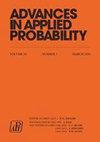关键集群级联
IF 1.2
4区 数学
Q3 STATISTICS & PROBABILITY
引用次数: 0
摘要
摘要我们考虑$\mathbb{R}^d$上的Poisson簇点过程序列:在步骤$n\in\mathbb{N}_0$的构造,对于一些$c>0$,簇中心具有强度$c/(n+1)$,并且每个簇由分支随机游动的粒子组成,直到第n代——由平均值为1的点过程生成。我们证明了这种“临界簇级联”的收敛性很弱,并且极限点过程等于空位过程(消光),或者它与临界簇级联具有相同的强度c(持久性)。我们获得持久性,当且仅当增长临界分支随机行走的Palm版本是局部几乎肯定有限的。这一结果使我们能够给出许多持久关键集群级联的例子。本文章由计算机程序翻译,如有差异,请以英文原文为准。
Critical cluster cascades
Abstract We consider a sequence of Poisson cluster point processes on
$\mathbb{R}^d$
: at step
$n\in\mathbb{N}_0$
of the construction, the cluster centers have intensity
$c/(n+1)$
for some
$c>0$
, and each cluster consists of the particles of a branching random walk up to generation n—generated by a point process with mean 1. We show that this ‘critical cluster cascade’ converges weakly, and that either the limit point process equals the void process (extinction), or it has the same intensity c as the critical cluster cascade (persistence). We obtain persistence if and only if the Palm version of the outgrown critical branching random walk is locally almost surely finite. This result allows us to give numerous examples for persistent critical cluster cascades.
求助全文
通过发布文献求助,成功后即可免费获取论文全文。
去求助
来源期刊

Advances in Applied Probability
数学-统计学与概率论
CiteScore
2.00
自引率
0.00%
发文量
64
审稿时长
6-12 weeks
期刊介绍:
The Advances in Applied Probability has been published by the Applied Probability Trust for over four decades, and is a companion publication to the Journal of Applied Probability. It contains mathematical and scientific papers of interest to applied probabilists, with emphasis on applications in a broad spectrum of disciplines, including the biosciences, operations research, telecommunications, computer science, engineering, epidemiology, financial mathematics, the physical and social sciences, and any field where stochastic modeling is used.
A submission to Applied Probability represents a submission that may, at the Editor-in-Chief’s discretion, appear in either the Journal of Applied Probability or the Advances in Applied Probability. Typically, shorter papers appear in the Journal, with longer contributions appearing in the Advances.
 求助内容:
求助内容: 应助结果提醒方式:
应助结果提醒方式:


